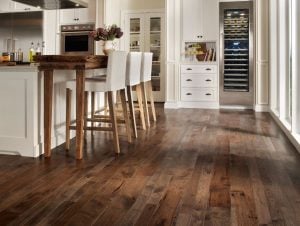[AdSense-A]Sanding and staining hardwood floors may be one of the most important home DIY projects, and one that will take a whole lot of consideration. Many will say it’s not for everyone, but this doesn’t mean everyone can’t do it. Sanding hardwood floors take a great deal of patience, time, and persistence, and staining makes it all worth it when it’s all said and done.
Sanding floors it the first step in this DIY home project that will prove to be quite difficult for some, but with the right information it’ll take the worrying out of the project itself. Hardwood floors can be refinished numerous times throughout its entire lifespan which can reach as high as 100 years when looking at many factors including the thickness of the hardwood, and quality of each refinish.
You’ll soon find out that sanding and staining hardwood floors will give you a brand new look at a fraction of the  cost. The time it takes a professional to do can range from 2 days to 2 weeks depending on the size and extent of the job and will cost you anywhere between $1.50 and $4.00/sq foot. The cost of this DIY project will only consist of the materials needed such as renting a sander, sandpaper, stain, polyurethane, and anything else which will only set you back around $150 – $300.
cost. The time it takes a professional to do can range from 2 days to 2 weeks depending on the size and extent of the job and will cost you anywhere between $1.50 and $4.00/sq foot. The cost of this DIY project will only consist of the materials needed such as renting a sander, sandpaper, stain, polyurethane, and anything else which will only set you back around $150 – $300.
Below is all you need to know on how to sand and stain hard wood floors including some tips and tricks from the pros.
Prepare for Sanding
First and foremost, you want to take the time to make sure that not only is this project for you, but if it’s possible at all. Typically, hardwood floors can be refinished numerous times over a 100-year lifespan, but it depends on the current thickness of the floor itself. When hardwood is refinished, the sanding sheds off layers of wood which over-time thins it out. Also, conventional use such as walking on on the hardwood will reduce the surface thickness in the same manner.
Once you verify it can be done, it’s time to completely prepare the room. You want to move out all furnishings and make arrangements to keep the area as undisturbed as much as possible. You’ll want to look for any nails or staples that protrude over the top of the floor and simply hit with a hammer or remove the all-together. Make sure all hardwood floor boards are secure in the same manner.
Apply Filler into Cracks, Holes, and Other Blemishes
Unfortunately, from years of use and abuse, you may encounter some blemishes such as cracks or holes. For this, you will want to use some filler prior to sanding to help give your hardwood that new look you’re looking for. Sanding afterwards will help blend in the filler giving it more of a natural look.
Wood filler or putty is relatively cheap and easy to use. You’ll want to make sure you match the color of the filler to the color of the wood instead of the type of the wood. Make sure the filler is completely dry before sanding.
Sanding the Hardwood
Depending on the size and extent of the project, sanding hardwood floors can be a labor intensive and very time consuming project. Sanding may differ slightly depending on the type of sander you use. In many instances, choosing more than one which would be complimentary to each other may be the best option.
You can expect to sand with at least three variants of sandpaper grits. Depending on the sander you choose and the extent of the work, the amount of passes with each grit will vary. Starting off with a drum sander will help reduce the wood and eliminate the old finish or a belt sander which is also very aggressive, but will take a bit longer. Going over the same area with a random orbital sander will help eliminate surface scratches which at times can be caused by the drum sander which will give the bulk of the room the finished look.
Check Out These Tips for Sanding Hardwood Floors with a Belt Sander
Ending with an edger sander for the area closest to the wall and a corner sander while using the same combination of sandpaper grit which was used with the first two sanders will help create a natural flow.
Staining the Hardwood
After sanding, staining the hardwood is the last step to give yourself new, but refinished floors. If the natural look isn’t exactly for you, then there are many different colors of stain to choose from. You’ll want to consider your surroundings such as the color and type of furniture as well as other items within the room. Color and material contrast are all things worth considering while choosing your stain.
When staining, you’re looking at applying at least two coats. You’ll want to evaluate the floors between each coat and don’t be surprised if you have to sand again if you see any blemishes in the hardwood or stain itself. If so, use a very fine grit of paper and then reapply another coat of stain after sanding.
Applying Finish
After staining, it’s recommended applying a finish as the last step. There are three different coats of finish to choose from including a polyurethane finish which is better for high traffic areas, water based finished which is eco-friendly but not as durable as polyurethane, and an acid cured finish. The last is a two-part finish that dries relatively quick, but many brands have a strong odor and can be flammable during the application and drying process.
[AdSense-A]






I really like your advice to apply finish to your hardwood floor. As you said, it only makes sense to want to check out the different options you have for finishing. Do you have any other tips about sanding your hardwood floor? I would do it on my own, but I’m thinking I may need to research some professionals for help.
Nice info. Thanks for your lovely article. It’s the most important DIY projects for the home but I never used before. After viewing your article I have decided to buy a hardwood floor sander.
Thanks for your article.
I would like to prepare my piano to get repainted. However, I need to get everything sanded down before anything else. I would like to be able to have everything sanded down.
It was quite nice how you said that hardwood flooring needs to be secured and undisturbed prior to refinishing and that means that everything, including furniture, should be moved out of the way. I will definitely tell that to my sister because she’s the one interested in refinishing the hardwood flooring of the house. However, I feel strongly that it’s something that we can’t do ourselves, so I’ll suggest hiring professional to carry out the rest of the task. Thanks!
4